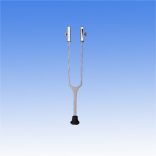Please Feedback for More after Reading.
Ryder-Seiffer tuning fork is similar but not identical to the traditional tuning fork because there are two triangular cones in both ends of the tuning fork respectively. There is a black triangular cone in the left side and a hollow triangle cone in the right side which have calibrations, that is 0 to 8 from bottom to top correspondingly.
When the tuning fork is vibrating, the black triangular cone in the left would turn into two gray triangular cones while the intersecting area would be a small black triangle. And with descending of vibrating, this black triangle peak is arising from bottom to up gradually. Write down the calibration when the patient cannot feel the vibration. The triangular cone in the right also would turn into two triangular cones and while the intersecting area would be a small white triangle. And with descending of vibrating, this white triangle peak is arising from bottom to up gradually. Write down the calibration when the patient cannot feel the vibration.
Diagnosing Steps:
1. Make sure that the patient close eyes.
2. Keep the patient’s foot on flat surface or chair.
3. Put the tuning fork on articular surface processus of patient’s big toe nail, simultaneously, give a finger to strut the patient’s big toe, and feel the vibration.
4. Write down the calibration when the patient cannot feel the vibration.
5. If the calibration is greater than or equal to 5,
the patient’s vibrating sensation is fine.
6.If the calibration is less-than 5,
the patient’s vibrating sensation is abnormal 



